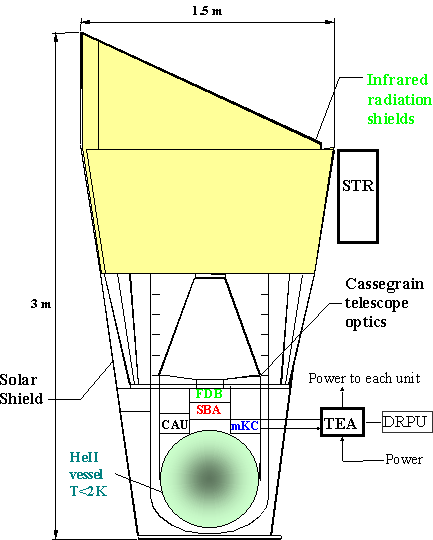Free flying spacecraft with the
Submillimeter Wave Cryogenic Telescope
picture (click to enlarge)

Submillimeter Wave Cryogenic Telescope
for the International Space Station
Introduction
The objectives of the Submillmetron Project
Experiment configuration
Main parameters
Cryogenic Telescope parameters
|
Block diagram of the Cryogenic Telescope
Free flying spacecraft with the Submillimeter Wave Cryogenic Telescope picture (click to enlarge) |

|
The Submillimetron is the international project of the space telescope for astronomical studies at submillimeter and millimeter wavelengths using facilities of the Russian segment of the International Space Station (ISS). The concept of Submillimetron telescope includes a 60 cm mirror telescope cooled to liquid helium temperature combined with a new type of supersensitive microbolometers arrays. This combination gives unique possibility to realize background limited sensitivity in the spectral minimum of the extraterrestrial background electromagnetic radiation around frequency 1 THz. This region is between peaks of galactic dust emission and extragalactic cosmic microwave background (CMB) measured by COBE satellite. The angular resolution about 1 arcmin and field of about 1o are similar to IRAS satellite survey, but more then order of magnitude better sensitivity about 10-18 W Hz-1/2 and another spectral region permits reveal in full sky survey sufficiently more new astrophysical objects. For following space missions Herschel (FIRST), Planck, IRIS these results will give useful complementary information of measurements with different angular resolution in another spectral regions. Next feature of the project is the concept of free flying instrument with periodic docking to ISS. Unlike to the usual concept of an autonomous mission this one gives possibility to combine low cost with reliability, refilling, repairment and maintenance. The initiative of the Project was done in Astro Space Center of the P.N. Lebedev Institute after discussions with NASA and JPL, supported later by the Russian Academy of Sciences. The proposal was undertaken to feasibility study in S.P. Korolev Rocket Space Corporation Energia (RSCE) and approved by the Russian Space Agency for the 2-d stage of ISS realization after years 2004 - 2005. The project is accepted for implementation by RSCE, which is responsible for the core of the ISS, its Russian Segment.
Orbit: circular orbit at an altitude of approximately
444 km with a 51.6o inclination.
Delivery to initial ISS orbit: modified cargo-ship Progress
Payload: the Submillimeter Cryogenic Telescope
The Cryogenic Telescope parameters are:
Diameter: D=0.6 m
Optical system: two-mirror Cassegrain
Cooling:
Detector arrays:
in submillimeter bands 1D arrays, 10-300 elements each.
Sensitivity of the detectors 10-18 W/Hz1/2
Angular resolution:
submillimeter bands: 1-10 min of arc (diffraction limited)
Sensitivity of the telescope (integration time = 1 s) in submillimeter bands: 3-12 mJy.
Block diagram of the Cryogenic Telescope |
|
 |
STR - Star Tracker,
determines the pointing of the telescope; HeII – superfluid helium vessel T=2K, cooling of primary and secondary mirrors; FDB - Focal Dichroic Beam-splitters assembly; SBA - Submillimeter Bolometer Array; CAU - Cool Electronics Unit (amplifiers and control circuits); mKC - milli-Kelvin Cooler (T<300 mK); TEA – Telescope Electronics Assembly, DRPU - Data Registration and Processing Unit. |